List of artificial objects on extraterrestrial surfaces
This is a partial list of artificial objects left on extraterrestrial surfaces.
Artificial objects on Venus
Artificial objects on the Moon
Artificial objects on Mars
Artificial objects on other extraterrestrial bodies
| Surface | Object | Mass | Owner | Landing | Location | Ref. | |
|---|---|---|---|---|---|---|---|
| 67P/Churyumov–Gerasimenko | Philae | 100 kg (220 lb) | 12 November 2014 | "Abydos" | |||
| Rosetta | 1,230 kg (2,710 lb) | 30 September 2016 | "Sais" | ||||
| 433 Eros | NEAR Shoemaker | 487 kg (1,074 lb) | 12 February 2001 | South of Himeros crater | [1] | ||
| 25143 Itokawa | Hayabusa target marker | 0.6 kg (1.3 lb) | 20 November 2005 | Muses Sea | [2] | ||
| Mercury | MESSENGER | 1,108 kg (2,443 lb) | 30 April 2015 | Suisei Planitia | |||
| 162173 Ryugu | MASCOT | 9.6 kg (21 lb) | 3 October 2018 | Alice's Wonderland | [3][4][5] | ||
| MINERVA-II Rover-1A | 1.1 kg (2.4 lb) | 21 September 2018 | Tritonis | [6][7][5] | |||
| MINERVA-II Rover-1B | 1.1 kg (2.4 lb) | ||||||
| MINERVA-II Rover-2 | 1.0 kg (2.2 lb) | October 2019 | Unknown | [8][9] | |||
| Hayabusa2 Small Carry-on Impactor | 2.5 kg (5.5 lb) | 5 April 2019 | "C01" | [10][11] | |||
| Hayabusa2 Deployable Camera 3 | ≈2.0 kg (4.4 lb) | April 2019 | Unknown | [12] | |||
| Hayabusa2 Target Marker B | 0.3 kg (0.66 lb) | 25 October 2018 | "L08" | [13] | |||
| Hayabusa2 Target Marker A | 0.3 kg (0.66 lb) | 30 May 2019 | "S01" | [11] | |||
| Hayabusa2 Target Marker E | 0.3 kg (0.66 lb) | September 2019 | Unknown | [14] | |||
| Hayabusa2 Target Marker C | 0.3 kg (0.66 lb) | September 2019 | Unknown | [14] | |||
| 9P/Tempel | Deep Impact impactor | 372 kg (820 lb) | 4 July 2005 | ||||
| Titan | Huygens lander | 319 kg (703 lb) | 14 January 2005 | Northeast of Adiri | [15][16] | ||
| Huygens heat shield | Unknown | ||||||
| Huygens parachute | Unknown | ||||||
Estimated total masses of objects
| Surface | Total estimated mass of objects (kg) |
|---|---|
| Churyumov–Gerasimenko | 100 |
| Eros | 487 |
| Itokawa | 0.591 |
| Jupiter | 2,564 |
| Mars | 10,240 |
| Mercury | 507.9 |
| The Moon | 189,344 |
| Ryugu | 18.5 |
| Tempel 1 | 370 |
| Titan | 319 |
| Venus | 22,642 |
| Total | 226,586 |
Gallery
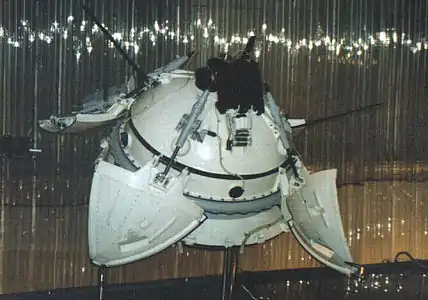 Mars 3 lander at the Memorial Museum of Cosmonautics in Russia
Mars 3 lander at the Memorial Museum of Cosmonautics in Russia MER-A Spirit rover lander
MER-A Spirit rover lander Apollo 15 Lunar Roving Vehicle in its final resting place on the Moon
Apollo 15 Lunar Roving Vehicle in its final resting place on the Moon

See also
References
- Spaceflight Now staff (28 February 2001). "NEAR Shoemaker phones home for the last time". Spaceflight Now. Archived from the original on 6 December 2018. Retrieved 7 December 2018.
NEAR Shoemaker now rests silently just to the south of the saddle-shaped feature Himeros...
- Rayl, A.J.S. (21 November 2005). "Hayabusa Does Not Land on Asteroid in First Attempt, But Successfully Delivers Target Marker". The Planetary Society. Archived from the original on 21 June 2011. Retrieved 6 December 2018.
...Sunday, November 20 (JST) JAXA received the signal that Hayabusa had carried out its task successfully [...] the target marker landed about six and a half minutes after it left Hayabusa, settling down just as planned in the nice flat region that the team dubbed Muses Sea...
- Wall, Mike (23 August 2018). "Landing Site on Asteroid Ryugu Chosen for Japan's Hayabusa2 Mission". Space.com. Archived from the original on 8 December 2018. Retrieved 8 December 2018.
The Hayabusa2 spacecraft's Mobile Asteroid Surface Scout (MASCOT) will land at a site in the asteroid Ryugu's southern hemisphere dubbed MA-9...
- Nowakowski, Tomasz (5 October 2018). "European MASCOT spacecraft successfully lands on asteroid Ryugu". Spaceflight Insider. Archived from the original on 8 December 2018. Retrieved 8 December 2018.
A small European spacecraft, known as the Mobile Asteroid Surface Scout (MASCOT), successfully landed on asteroid Ryugu on Wednesday, Oct. 3 [...] MASCOT weighs some 21 lbs. (9.6 kilograms)...
- "Correction to the name of the MINERVA-II1 landing site". JAXA. 1 February 2019.
- Lakdawalla, Emily (24 August 2018). "Hayabusa2 Team Announces Ryugu Landing Sites, Initial Science Survey Results". The Planetary Society. Archived from the original on 8 December 2018. Retrieved 8 December 2018.
"N6" marks the likely drop zone for MINERVA-II, which will deploy four microrovers.
- ABC/Wires (24 September 2018). "Hayabusa 2: Japanese space agency makes history by landing two rovers on an asteroid". ABC News Australia. Archived from the original on 8 December 2018. Retrieved 8 December 2018.
The rovers, each with a diameter of 18cm, height of 7cm and weight of about 1.1kg, were released from the Hayabusa2 spacecraft on Friday.
- The Downlink: Station Crew Home, Hayabusa2 Deploys Rover. Jason Davis, The Planetary Society. 4 October 2019.
- Hatabusa2 at Twitter. JAXA. Accessed on 7 October 2019.
- "Approach to the 2nd touchdown–Part 3: To go or not to go–". JAXA. 8 July 2019.
- "The Pinpoint Touchdown – Target Marker 1A (PPTD-TM1A) operation". JAXA. 5 May 2019.
- Gough, Evan (16 July 2019). "Hayabusa 2 is the First Spacecraft to Sample the Inside of an Asteroid". Universe Today.
- "The touchdown site". JAXA. 19 February 2019.
- "Target marker separation operation". JAXA. 16 September 2019.
- Cook, Jia-Rui C. (14 January 2010). "Land Ho! Huygens Plunged to Titan Surface 5 Years Ago". Jet Propulsion Laboratory. Archived from the original on 6 December 2018. Retrieved 6 December 2018.
The Huygens probe parachuted down to the surface of Saturn's haze-shrouded moon Titan exactly five years ago on Jan. 14, 2005 [...] as it plunged through Titan's hazy atmosphere and landed near a region now known as Adiri.
- NSSDCA staff (2005). "Huygens (NSSDCA/COSPAR ID: 1997-061C)". National Space Science Data Coordinated Archive (NSSDCA). Archived from the original on 6 December 2018. Retrieved 6 December 2018.
Mass: 319 kg
This article is issued from Wikipedia. The text is licensed under Creative Commons - Attribution - Sharealike. Additional terms may apply for the media files.
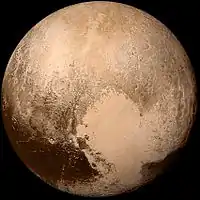
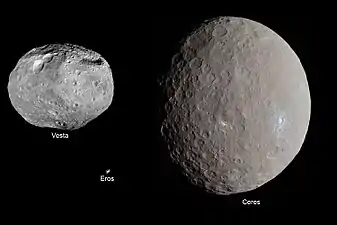
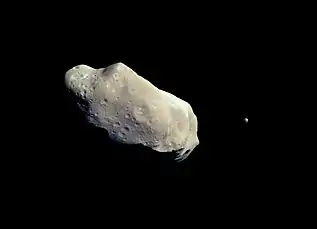
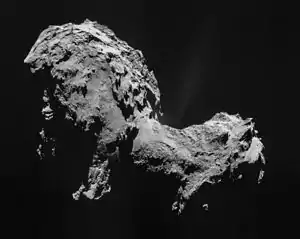
.jpg.webp)